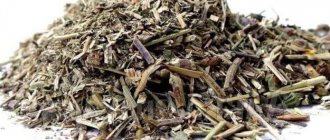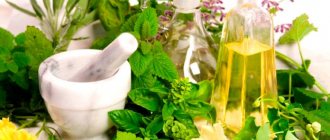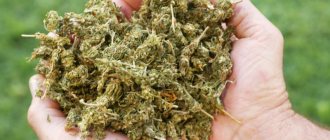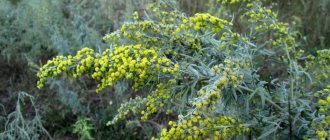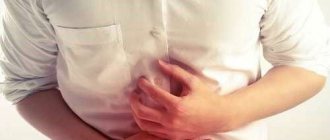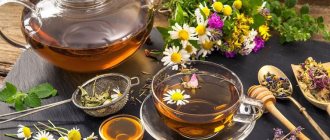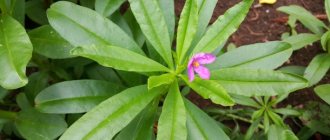Causes of pain
Pain during menstruation, as well as a few days before it, is familiar to many women. They can bother you from the moment of menarche, or appear suddenly. In the first case, we will most likely be talking about functional disorders caused by changes in prostaglandin metabolism. If pain suddenly appears, you should think about some kind of disease, for example, of an inflammatory nature, etc.
Primary algomenorrhea (painful periods) may be due to the following reasons:
- Endocrine disorders , as a result, the formation of prostaglandins increases and their destruction slows down. In this case, herbs and herbs that act like non-steroidal anti-inflammatory drugs are suitable.
- Neurovegetative characteristics of the female body . It is known that each person has his own pain sensitivity threshold. And what brings slight discomfort to one, brings unbearable sensations to another. Here it is better to give emphasis to various relaxation techniques.
- Features of the anatomy of the genital organs . If the body of the uterus is strongly bent in relation to the cervix, pain may appear due to impaired outflow of menstrual blood. Also, sometimes there are other obstacles in the way of discharge. Sometimes in such situations antispasmodics and changes in body position help.
- Disorder of sexual development . Various diseases that lead to abnormal sensitivity of myometrial cells or to their poor compliance, as, for example, with infantilism. Herbs are quite effective in this case.
The causes of secondary algomenorrhea are associated with the appearance of pathologies that disrupt the functioning of the uterus, lead to irritation of the peritoneum, etc. In general, this entails the occurrence of painful attacks. Such diseases include the following:
- Most often we have to deal with endometriosis. Moreover, the more widespread the process, the more severe the pain. They can be localized in the lower abdomen, in the rectum and other places.
- Uterine fibroids can cause pain in different cases: with the submucosal location of the nodes, with their “birth”, with a malnutrition and necrosis, etc.
- Inflammatory diseases of the genital organs. In this case, pain is often accompanied by other pathological symptoms - discharge, infertility, etc.
- The intrauterine device, especially if it is displaced or incorrectly selected.
- Undiagnosed injuries after childbirth, most often ruptures of the uterine ligaments.
- Varicose veins of the pelvis. Herbs that affect the properties of blood help well in this case. And if you take them in addition to the practice of yoga and gymnastics, the effect will not be long in coming.
- Anomalies in the development of the genital organs, for example, accessory horn, duplication of the uterine body, atresia of the cervical canal and others. In this case, with a certain amount of accumulated menstrual blood, pain occurs due to the pressure pushing on the walls of the organ. In such situations, treatment requires medical intervention.
We recommend reading the article about algomenorrhea. From it you will learn about the causes of the disease, symptoms, diagnosis of algomenorrhea and treatment of painful periods.
What herbs to drink during menstruation
You can reduce blood loss during menstruation by taking decoctions and infusions of hemostatic herbs during menstruation. A positive effect is observed when using pharmaceutical tinctures and self-prepared medicinal products. But they can be taken only after the cause of heavy periods has been established in agreement with the treating gynecologist.
Most often, the following hemostatic herbs are used to reduce the volume of discharge:
- nettle;
- carnation;
- yarrow;
- shepherd's purse;
- red brush;
- water pepper;
- hog uterus.
Other herbs can also be used for medicinal purposes for heavy menstrual bleeding. For some, horsetail and corn silk help reduce the intensity of discharge.
But before taking herbs, you need to understand the principle of action of each of them, find out the list of indications and contraindications for use.
Hog queen
With heavy menstrual flow, many begin to drink an infusion of boron uterus. This herb, which stops bleeding during menstruation, will help those women whose hormonal balance in the body is disrupted during the premenopausal period.
Important! The hog uterus is capable of increasing discharge. But for women with uterine fibroids and endometriosis, the herb has a different effect; it reduces the intensity of menstruation.
In patients with endometriosis, consuming boron uterus reduces the number of endometriosis lesions. For fibroids, drinking an infusion of herbs helps reduce the activity of benign tumor cells.
In pharmacies you can find a ready-made alcohol infusion. You can also use self-prepared hemostatic decoctions and infusions for medicinal purposes. To achieve a therapeutic effect, they must be taken for 3 consecutive cycles, with the exception of menstruation days.
The decoction is made from 200 ml of water and 1 tbsp. l. dried boron uterus. Boil the herb over low heat for ¼ hour. After cooling, the liquid must be drained through a sieve. Patients with heavy periods should take boron uterus three times a day in a dosage of 1 tbsp. l. The finished hemostatic agent should be stored only in the refrigerator, the shelf life is 5 days.
To prepare an alcoholic infusion, pour 60 g of herb into 0.5 liters of vodka and let it brew in a dark place for 2 weeks. If you have heavy periods, you should take the prepared hemostatic medicine 1 tsp three times a day.
water pepper
Water pepper tincture is often prescribed by gynecologists to women after miscarriages or abortions. This plant helps reduce the permeability of blood vessels, enhance the process of blood clotting and increase the tone of the uterine muscles.
The hemostatic effect of this folk remedy during menstruation becomes noticeable already in the first month of treatment. The recommended duration of therapy is 3 months. The easiest way is to use a ready-made pharmacy tincture, but you can make a medicinal decoction yourself.
To prepare a water infusion you need 1 tbsp. l. pour water pepper herbs into a glass of boiling water. After 2 hours, filter the liquid. Take the prepared medicine for heavy periods three times a day, 1 tbsp. l. The pharmaceutical extract should be consumed 30 drops twice a day on an empty stomach.
Carnation
For heavy periods, a decoction of cloves is used as a hemostatic agent. It is most effective in cases where the patient has heavy discharge due to uterine atony. The plant has a hemostatic, astringent and analgesic effect.
The dried, crushed herb is poured with boiling water and allowed to brew for 2 hours. For 1 glass of water, the raw material is taken in the amount of 1 tbsp. l. You should take the prepared product three times a day, 1 tbsp. l.
Kalina
For medicinal purposes, patients with heavy periods are advised to use a decoction of viburnum bark. It has a hemostatic, astringent effect, and reduces the activity of uterine contractions.
To prepare the remedy, take 25 g of dry bark, pour in ¼ liter of boiling water and boil for 20 minutes. After cooling, the liquid is filtered and brought to the original volume with boiled water. You need to drink 15-20 ml up to 5 times a day.
Nettle
The hemostatic effect of nettle has been known since ancient times. It is due to the inclusion of large amounts of vitamin C.
To prepare the decoction you will need 200 ml of water and 1 tbsp of dried nettle leaves. l. Pour boiling water over the grass and boil for 10 minutes. The cooled hemostatic decoction must be filtered. It should be taken 1 tbsp. l. 4-5 times a day.
You can use ready-made nettle extract. For heavy periods and bleeding, it is recommended to drink 30-40 drops on an empty stomach. They are diluted in 100 ml of water and drunk in one gulp. You can eat only half an hour after taking the medicine.
Attention! When using nettle, blood flow to the uterus is reduced and blood circulation in the pelvic area is stimulated.
There are other ways to prepare nettles:
Red brush
Patients with heavy periods, the appearance of which is caused by hormonal imbalance or uterine fibroids, are recommended to take a red brush, which has hemostatic properties. A decoction or alcohol infusion is made from the root of the plant. Can be treated with a combination of red brush and hog uterus to enhance the hemostatic effect.
This folk remedy is used for heavy periods with clots. If you start taking it after the start of your period, the effect will become noticeable no earlier than the 3rd day of treatment.
To prepare the decoction, you will need 50 g of finely ground root. The raw material should be poured with ½ liter of water and simmered over low heat for about 1 hour. It is recommended to take a hemostatic decoction 100 times a day. To improve the taste of the drink, you can add 1 tsp per glass of decoction. honey
Herbs effective for period pain
So, in each clinical situation a certain set of herbs will be most effective. But it is not always possible to accurately determine the nature of the pain. And many plants do not have a specific effect, but affect the body as a whole.
The main herbs for painful periods are elecampane, nettle, horsetail, water pepper, shepherd's purse, calendula and some others.
Elecampane
This plant has a multifaceted effect and is used for various diseases. Helps with prostaglandin imbalance, endometriosis and other causes of painful menstruation.
- Recipe 1. Take the dried root, finely grate it and pour a glass of hot water. Bring to a boil and keep on fire for 10 - 15 minutes. After which you still need to let it brew for 3 - 4 hours. You should take 2 - 3 tbsp. l. 2 - 3 times a day.
- Recipe 2. Take crushed elecampane root, St. John's wort, chamomile flowers and oak bark in equal quantities and add 1 liter of hot water. It is advisable to place the solution in a thermos or somewhere dark. Let it brew for 4 - 5 hours, then drink it like tea.
Nettle
This, as many believe, “weed” contains a large amount of vitamins and microelements that are beneficial for the female body. It is better to use nettle when there is a combination of heavy and painful periods, for example, with endometriosis.
- Recipe 1. You need to collect fresh leaves of stinging nettle and squeeze the juice out of them. You should take 1 - 2 tbsp. l. 2 - 3 times a day throughout all critical days.
- Recipe 2. You can also buy nettle extract, an alcohol solution at the pharmacy and drink 3 drops 3-4 times a day.
Horsetail
You can use one plant or combine it with other herbs.
- Recipe 1 . You should take 3 - 4 tbsp. l. horsetail, chop it and pour in 500 ml of water, which has previously been boiled over fire for 5 minutes. Let stand for 30 - 40 minutes. Take a glass 2-3 times a day.
- Recipe 2. It is necessary to take the following crushed herbs in equal proportions: horsetail, St. John's wort, valerian and oak. Mix and pour 600 - 800 ml of hot water and leave for 20 - 30 minutes. You should drink 150 - 200 ml 2 - 3 times a day as tea. It is useful to add 15 - 20 drops of alcohol tincture of motherwort or valerian.
water pepper
Particularly useful for uterine fibroids, endometriosis, as well as a combination of painful and heavy menstruation.
- Recipe 1. Take 1 tbsp. l. finely chopped plant and pour 200 - 250 ml of hot water. Leave in a water bath for 15-20 minutes, after which you can drink the solution (take 2-3 tablespoons warm, 3-4 times a day).
- Recipe 2 . It is necessary to mix crushed water pepper and twice as much yarrow. Then pour the resulting mixture with 2 liters of hot water and let it brew for about half an hour. You should drink 150 - 200 ml 2 - 3 times a day.
Wild strawberry
The leaves of the plant are useful for treating menstrual irregularities, heavy and painful periods.
- Recipe 1. Take 1 tbsp. l. dried leaves and pour 200 - 300 ml of hot water. Let it brew for 20 - 30 minutes, after which you can take 100 - 150 ml several times a day.
- Recipe 2. Fresh crushed strawberry leaves in the amount of 1 glass should be poured with 1 liter of water and boiled, kept on fire for at least 20 minutes, then let the solution cool. Bring the resulting drink with boiled water to a volume of 1 liter, after which you can take half a glass 2 - 3 times a day.
Calendula
An alcohol solution of calendula can be used for douching for inflammation in the vagina, while infusions help with heavy and painful menstruation. It is especially useful for various disorders in women during menopause.
- Recipe. It is necessary to take calendula flowers, daisies, and St. John's wort herbs in equal quantities. Pour 500 ml of hot water and add 1 tbsp. l. alcohol tincture of motherwort. Let it brew for about 2 - 3 hours. Add the resulting solution 10 - 20 drops to tea several times a day.
Herbs and teas for menstruation: what to drink during painful menstruation
Regularly every month, the process of blood clots leaving the uterus occurs in the female body, which is accompanied by painful sensations, a broken state and irritability. These periods in a woman’s life pass during reproductive age and are aimed at the possibility of conceiving a child. We are talking about menstruation.
Norm or pathology
Pain during menstruation can be mild, moderate, or very severe. But how can you determine whether your sensations and general condition are normal, or whether they are already beyond the norm?
Pain these days should be tolerable and amenable to treatment with analgesics and antispasmodics. If the spasms are so strong that “you want to climb the wall,” then you should think about it.
Possible causes of severe cramps
- Elementary lack of B vitamins and microelements: Mg, P, Ca;
- Hyperthyroidism. Excessive activity of the thyroid gland increases the concentration of prostaglandins in the female body to a critical point. The consequence is severe pain and a long and intense period of menstruation;
- Sexual infantilism. Often found in young girls, it is characterized by uterine hypoplasia or its abnormal location. The girl should definitely be shown to a gynecologist;
- Endometriosis. There are situations when excess endometrium spreads outside the uterus and is exposed to prostaglandins.
If you notice, in addition to severe pain, symptoms such as excessive bleeding, bleeding outside of your period, 7 days before your period, a tightening in the lower abdomen, and all this is accompanied by pain during sexual intercourse, then you should see a doctor;
- Inflammation. In addition to pain, this diagnosis can be indicated by: fever, chills, nausea, nagging pain in the lower abdomen after menstruation. These symptoms overlap with the symptoms of an infectious disease of the genital organs, as well as hormonal disorders;
- Cysts, fibroids, fibroids, tumors tend to show themselves more actively these days.
Tea for menstruation
Fireweed has many beneficial properties. But how can they help a woman during a difficult period? And it’s very simple, affecting all unpleasant sensations at once:
- It has an analgesic effect due to the effect of the vitamin C it contains on the body. It relieves heaviness in the lower abdomen and migraines caused by hormonal surges.
- Has an anti-inflammatory effect. It also strengthens the immune system, which makes the body invulnerable to infectious attacks.
- The medicinal herb contains tannins and has a high content of carotene, which improve the performance of the entire female genitourinary system.
- Sedation will help in the fight against irritability. It has a beneficial effect on the entire nervous system, reducing stress and nervousness.
- Koporye tea reduces the abundance of blood discharge, and in addition, prevents the possibility of internal bleeding.
- Tones the body, improves mood and reduces fatigue.
- In addition, fireweed will help regulate hormonal levels and restore cycle disruption.
Ivan tea during menstruation will become a real “friend” and even a “brother” for you, but for the full picture you are recommended to consult a specialist.
The beneficial properties of Koporye tea for menstruation have been known since ancient times. Our ancestors used various decoctions and tinctures of fireweed to ease the process of menstruation for those representatives of the fair sex for whom this process was very painful.
Fireweed herb (fireweed) contains many vitamins of various groups and a complex of minerals, as well as microelements necessary for the body (magnesium, potassium, phosphorus, iron, zinc and others). Thanks to this enriched composition, fireweed enriches the body with everything necessary and has many beneficial properties.
The drink can be consumed both directly for treatment and as a preventive measure.
Disruption of the menstrual cycle is a very common problem that occurs in modern women. This can happen both at a young age and in adulthood. To understand whether your cycle is disrupted or not, you need to understand which cycle will be considered normal.
The normal period during which all changes and processes occur in the body is considered to be a period of time from 20 to 35 days. During conception, menstruation does not occur - this is normal. Menstruation lasts no more than a week, usually 4-5 days. The peak of heavy bleeding is observed in the first 2-3 days, then the discharge becomes less.
In case of cycle disorders, a tea drink made from fireweed turns out to be very useful. It allows you to normalize the functioning of the entire reproductive system.
Recipes
There are several ways to prepare herbal infusion.
You can brew fireweed tea separately without additives, or you can add additional herbs and berries (to taste).
To prepare, you will need dried fireweed or a mixture of it with other herbs, which must be poured with boiling water at the rate of 30 grams of dry ingredients per 500 milliliters of boiling water. Leave for 10-15 minutes.
It can be brewed either in a special teapot or in separate single servings. Can be consumed separately, or with honey and other flavorings.
If you are not allergic to the components that are part of this drink, then you can drink it on a regular basis.
During menstruation, it is recommended to use the decoction for a week 3-4 times a day in portions of 100-150 milliliters. Best consumed one hour before meals.
Reviews
Koporye tea really helps with pain during menstruation. Listen to this review from Anastasia, in which she told how fireweed helped her (and not only by eliminating painful periods). She noted 4 therapeutic effects on her body.
And read how Alena (Moscow) speaks about fireweed tea, how she prefers to drink it these days and what else is wonderful about fireweed tea, in her opinion, and how else it has helped her.
Take 11 minutes to watch the video in which Elena Malysheva talks about how to cope with painful periods.
Herbs for menstruation
Herbal tea based on fireweed is not the only sure way to help women during their menstrual periods. Can other medicinal herbs be used? The answer is clear: YES!
The tincture is prepared on an alcohol basis: pour 100.0 g of crushed marina root into 1.0 liters of vodka, leave for half a month in a dark, cool place. Stir regularly (shaken). After 2 weeks, filter. The tincture is ready. Should be taken three times a day, half an hour before meals, 1 tsp.
- A collection of angelica, nettle roots, dandelion, licorice. We will need to prepare a decoction. We take the ingredients in equal parts. Next, we need to grind all the plants separately: grind the more fragile components with our fingers, pass the coarser ones through a coffee grinder or meat grinder.
Then mix everything, take 2.5 tbsp. collection, pour 0.5 liters of freshly boiled water and place in a water bath for a quarter of an hour, closing the lid.
An enamel or ceramic container is best for you. After removing from the bath, wrap it in a towel and leave for another half hour. Bring the infusion to its original volume using boiled water.
We filter and take a quarter glass orally four times a day.
- Collection of sage, mantle, peppermint, angustifolia fireweed.
Grind all the components one by one. Then mix everything in equal proportions. 2.5 tbsp. l. Pour the mixture into 500.0 ml of boiling water into a thermos. We forget about it for 2-3 hours. Then we filter and accept in the same way as the previous collection.
Even if menstruation does not particularly bother you, but you are still used to dealing with discomfort with medication, it is better to replace your usual antispasmodics with herbal teas or decoctions. After all, herbal products do not have a toxic effect on the body, and are not at all inferior in their pain-relieving properties to pharmaceutical competitors.
If during your period you not only have severe pain, but also your mood bounces around like a ping-pong ball, then spend 14 minutes on a video that talks about hormones and how exactly menstruation controls a woman’s life.
Source: https://ChayIvanKipreyevich.ru/realnaya-polza-ivan-chaya-pri-mesyachnyh/
General recommendations for relief
Even if you know which herbs reduce pain during menstruation, you won’t always have exactly the right plants at hand, and their effect is greatest if you take the formulations in advance.
Women prone to algomenorrhea should know general recommendations and additional ways to alleviate their condition.
These include:
- If pain during menstruation appears regularly, every cycle, there is no need to wait for the next attack. It is better to start taking medications that are effective for a particular woman in advance, a day or two before the usual onset of unpleasant episodes.
- Pain may improve in response to heat or cold. So, if algomenorrhea is accompanied by heavy menstruation, then it is better to apply a heating pad with ice (or just meat from the freezer, etc.). There is no need to worry that this could provoke an inflammatory process. But if the pain arose as a response to an infection, then this can aggravate its course. Therefore, if you suspect it, it is better not to use this method. A warm shower or a bottle of hot water is only suitable if a woman's periods are light. Otherwise, you can provoke bleeding.
- In addition to herbal medicine, you can take various pain relievers. In each situation, a different drug will be effective. For example, if the formation of prostaglandins is impaired, it is NSAIDs; with endometriosis, more serious medications or an increased dose are often needed, but regular use of oral contraceptives will help most effectively.
- Physical activity should be avoided.
- You can increase your pain threshold and thereby reduce the perception of discomfort caused by menstruation by practicing yoga, breathing exercises, etc. But the effect, of course, will not be immediate, but only with long-term and regular exercise.
- Taking a certain position, for example, with your legs bent and pressed to your chest, often helps relieve a pain attack.
- For pain caused by spasmodic contractions of the uterus and adhesive disease, tampons with dimexide help well. To do this, dissolve the product with boiled water in a ratio of 1:4. They need to be placed in the vagina for 4 to 6 hours.
Watch the video about painful menstruation:
Herbs for painful periods
Herbs for painful periods are an effective pain reliever and harmless folk remedy.
Painful periods or algodismenorrhea are manifested by cramping pain during menstruation in the lower abdomen and lumbar region. These pains arise due to contractions of the uterus caused by poor circulation in its muscle layer.
Painful periods may be accompanied by headaches, general weakness, nausea, and sometimes vomiting. Painful menstruation is observed more often in young women and girls.
The appearance of menstrual pain or secondary algodismenorrhea in older women is often associated with diseases of the genital organs: endometriosis, fibroids and uterine fibroids, sexually transmitted infections, inflammatory processes in the genital organs.
For painful periods, folk medicine uses medicinal herbs that have antispasmodic and analgesic effects.
Herbs for painful periods, traditional medicine recipes
Elecampane tall: pour 1 teaspoon of crushed elecampane roots with 1 glass of boiling water, leave for 6-8 hours, strain. Drink 0.5 cups (100ml) per day, divided into 3 doses, daily for painful and irregular periods.
Oregano: 1 tablespoon of dry oregano herb, pour 1 glass of boiling water, leave for 2 hours, strain. Drink 50ml (1/4 cup) 3 times a day for painful periods.
Kalina:
a) take 4 teaspoons of crushed viburnum bark, add 1 glass of water, bring to a boil and cook for 0.5 hours. Strain the broth while hot, add water to the original volume. Drink 1 tablespoon 3 times a day 30 minutes before meals for painful and heavy periods. b) a decoction of viburnum bark (1 handful of viburnum bark per 1 liter of water) is used for douching with a combination of painful and heavy menstruation. c) viburnum bark extract in 50% alcohol in a ratio of 1:10, take 20-30 drops 2-3 times a day 30 minutes before meals to eliminate pain during menstruation, as well as to stop uterine bleeding. d) 40g of viburnum bark, pour 500ml of vodka, leave for 7 days in a cool, dark place, strain. Drink ¼ tablespoon 3 times a day with warm water or tea.
Meadow clover : for painful and irregular periods, take 2 tablespoons of dry meadow clover inflorescences, pour 1 glass of boiling water, leave for 6-8 hours under the lid. Drink the entire infusion a day, 50 ml half an hour before meals.
Melissa officinalis: pour 15 dry herbs with 1 glass of boiling water, leave for 0.5 hours in a warm place or wrap. Drink 1-2 tablespoons 5-6 times a day for painful periods.
Potentilla goose:
a) decoction of cinquefoil herb: 20g per 200ml of water. Drink 2-3 tablespoons 3 times a day for painful periods, combine with a compress of this decoction on the lower abdomen. b) a decoction of cinquefoil fruits in milk works more effectively: 1 teaspoon of seeds per 1 glass of milk. Drink 2 times during the day.
Linden: pour 1 tablespoon of crushed linden flowers into 1 glass of boiling water, leave for 30 minutes, strain and drink warm ½ glass 2 times a day or drink the whole glass in the morning for painful, unstable periods that are out of whack with the normal rhythm of menstruation.
Water pepper: pour 1 tablespoon of chopped herbs into 1 glass of boiling water, leave for 1 hour. Drink 1 tablespoon for painful periods.
Garden parsley: 4 teaspoons of dry parsley seeds per 1 cup of boiling water, boil for 15 minutes over very low heat, cool, strain. Drink 1 tbsp. spoon 5-6 times a day 2 hours after meals.
Common wormwood (Chernobyl):
a) Brew 1 teaspoon of Chernobyl herb with 1 glass of boiling water and let cool. Drink 70 ml (1/3) glass 3 times a day half an hour before meals for painful and heavy periods. Start treatment a week before the start of your period and end 5 days after it ends. b) 3-5 dry finely chopped Chernobyl roots, pour 2 liters (10 glasses) of boiling water, prepare a decoction. Drink 0.5 glasses a day until pain and bleeding decrease. c) pour 3 tablespoons of dry herb into 1 glass of hot water, bring to a boil and cook for 5-10 minutes, then strain and squeeze. Dilute the resulting volume of decoction with boiled water to 1 liter. Use for douching for painful periods.
d) 1 tablespoon of crushed wormwood root, pour 1 glass of boiling water, boil for 15 minutes, strain, dilute the volume with boiled water to 1 liter and use for douching for painful periods.
Rue fragrant: 1 teaspoon of rue leaves per 1 glass of boiling water, leave for 10 minutes, drink 1 glass in the morning and evening. Rue infusion reduces pain in women with menstrual disorders.
Horsetail : pour 1 teaspoon of herb with 2 cups of boiling water, leave for 10-15 minutes. Drink 1 tablespoon every 2 hours for heavy and painful periods.
After reducing pain and bleeding, drink 1 tablespoon 3 times a day.
Hare cabbage (oxalis) : 2 table. spoons of dry crushed sorrel, pour 400 ml of boiling water, leave for 15 minutes. Drink 100 ml 4 times a day for painful menstruation.
Celery : ½ teaspoon of celery seeds, pour 1 glass of boiled water, leave for 8-10 hours, strain. Drink 1 tablespoon of infusion 0.5 hours before meals 4 times a day for painful periods.
Herbal teas for painful periods
***
Collection 1 : knotweed, grass 1h, horsetail, grass 1h, centaury, grass 3h, cinquefoil, grass 5h. Take 1 tablespoon of the crushed collection, pour 2 cups of boiling water, leave for 1 hour. Drink in sips a day for painful periods.
***
Collection 2 : chamomile 2h, water pepper, herb 4h, dead white nettle (white nettle), flowers 2h, love spell, herb 2h. Take 1 tablespoon of the mixture, add 300 ml of water, boil for 15 minutes, cool. Drink 1-3 glasses a day during painful menstruation.
***
Collection 3 : heart-shaped linden flowers 30g, oregano flowers 29g, horsetail leaves 20g, wild strawberry leaves 20g. Pour the entire mixture into 500 ml of water, bring to a boil, pour into a thermos, leave for 1 hour, strain. Drink ¼ glass 3 times a day before meals.
***
Collection 4: horehound, grass 2.5 hours, fragrant rue, leaves 1 hour, forest rolls, flowers 1.5 hours. Take 1 tablespoon of the mixture, pour 1 glass of water, boil for 30 minutes, leave until cool, drink 1 glass 3 times a day during scanty menstruation with pain in the lower abdomen.
***
Collection 5 : lemon balm, leaves 40g, peppermint, leaves 30g, thyme, flowers 30g, great celandine, leaves 20g. Pour the entire mixture into 500 ml of water, bring to a boil over low heat, leave covered for 4 hours. Drink 1 glass 2 times a day 40 minutes before meals for painful periods.
***
Collection 6: sorrel leaves 50g, large plantain leaves 50g, water 400ml. Pass fresh sorrel and plantain leaves through a meat grinder and squeeze. Mix the resulting juice with 400 ml of chilled boiled water and drink 1/3 cup 3 times a day 20 minutes before meals.
***
Collection 7 : valerian root 20g, peppermint leaves 25g, chamomile flowers 25g, silver birch leaves 25g. Pour the entire mixture with 500 ml of water overnight, boil for 5-10 minutes in the morning, leave covered for 1-2 hours, strain, add water to the original volume. Drink 1/3 glass 2 times a day after meals every 25 minutes for 10 days.
***
Collection 8 : viburnum bark 35g, blackberry leaves 40g, raspberry leaves 40g. Pour the crushed mixture of herbs into 1 liter of heated red semi-dry wine, leave in a dark, cool place for 10 days, then bring to a boil, cool, strain. Drink ¼ glass 3 times a day 20 minutes after meals for 7 days during painful periods.
Below are recipes for herbs and herbal mixtures used in folk medicine for painful periods.
Medicines for when it hurts a lot
The most effective way to cope with such conditions is with the help of various groups of painkillers. They can be used in the form of suppositories, tablets, or even injections for severe attacks.
The most effective medications are:
- Non-steroidal anti-inflammatory drugs. They include a large group - from the very first (aspirin) to modern ones (naproxen, piroxicam, etc.). Paracetamol, ketones, ibuprofen, and indomethacin are also effective. The last two medications can be used in the form of suppositories, which has a number of advantages.
- Antispasmodics help with painful contractions of the uterus, with adhesions, and with intestinal bloating (women often mistake these pains for menstrual pain). These are drotaverine (no-shpa), papaverine and others.
- Analgesics, including central action. These are analgin, spasmalgon, baralgin, peretin.
But everything should be used taking into account contraindications, without exceeding the permissible dose. Otherwise, in addition to everything else, you may get an exacerbation or the appearance of new painful conditions.
What you should absolutely not do
If all the symptoms during critical days are normal, you can safely drink herbs and expect an effect from them. But if you experience severe, paroxysmal pain, you should seek medical help. Only a specialist can exclude acute, life-threatening conditions. So, you need to see a doctor if you are concerned about the following:
- if a woman suspects that she is pregnant;
- when the pain lasts longer than usual;
- with very heavy discharge;
- when the temperature rises or other alarming symptoms appear (dizziness, vomiting, etc.).
The use of traditional medicine in the treatment of algomenorrhea has a fairly high effectiveness. The main thing is to choose the most suitable and convenient recipe. But it is better to use these methods after the cause of the disease has been established, because these symptoms may hide a serious pathology. Only a doctor can prescribe the most correct treatment, including advice on what herbs you can drink for menstrual pain in a given clinical situation.
Similar articles
- Chamomile for menstruation: is it effective for delayed...
for menstrual dysfunction: is chamomile useful for delayed menstruation, heavy, acyclic discharge, etc. ... This plant can also help with spastic pain in the lower abdomen. It is necessary to take flowers in equal parts... Read more - Sage for menstruation | Healing properties of the herb
Sage during menstruation is indicated for stabilizing the cycle, which helps not ... Healing properties of the herb. Since ancient times, sage has been recommended for prolonging... Sage decoction reduces the concentration of abdominal pain-causing substances in... Read more
- Herbs for heavy periods: which ones stop...
Long, heavy periods don't just happen. Herbs will help with heavy periods, which act as hemostatic drugs. ... Herbs for menstrual pain: which ones reduce pain, how ... Read more
- Algomenorrhea: causes, symptoms, classification...
Pain that increases with each menstrual period turns primary algomenorrhea into decompensated one. ... Herbs for menstrual pain: which ones reduce pain, how... Read more
- Shepherd's purse for menstruation: how the herb will help with...
For severe bleeding and pain during menstruation, a good effect is noted when taking the juice of the shepherd's bursa in various combinations. ... Herbs for heavy periods: which ones stop... Read more
- Tempalgin for menstruation: will it help with pain...
In 100% of cases, menstrual bleeding will increase, which will only worsen the woman’s condition. ... Herbs for menstrual pain: which ones reduce pain, how ... Read more
Herbs for PMS and painful menstruation
Premenstrual syndrome, abbreviated as PMS, is a condition that occurs in most women a few days (2-10) before menstruation and is characterized by various health disorders: vegetative-vascular, psycho-emotional, metabolic processes.
The most common: mood swings, irritability, weakness, increased appetite, pain in the chest, lower abdomen and lumbar region.
Decoctions and infusions of medicinal plants will help alleviate the condition safely during such a difficult period, as well as during menstruation.
Recipes for emotional disorders
Melissa infusion:
- 2 tbsp. dry lemon balm herb;
- 1 tbsp. boiling water
Pour boiling water over the lemon balm and let it brew for 2-3 hours. Strain. Drink throughout the day instead of tea. In addition to relieving irritability, lemon balm also soothes pain. Infusion of the initial letter:
- 1 tbsp. herbs medicinal caps;
- 1 tbsp. boiling water
Pour boiling water over the initial cap, let it brew for 6 hours under the lid and strain. Drink 1/4 glass 4 times a day. This infusion also helps with excessive sweating. Calming collection:
- 10 g of cinquefoil herb;
- 10 g yarrow herb;
- 10 g chamomile flowers;
- 5 g celandine herb;
- 2 tbsp. boiling water
Pour boiling water over the plant material, let it brew for 30-40 minutes and strain. Drink small portions throughout the day.
Herbal tea:
- cuff grass;
- lemon balm leaf;
- angustifolia peony flowers;
- chamomile flowers.
Mix crushed herbs taken in equal quantities. Brew 1 tablespoon with a glass of boiling water, let it brew for 10 minutes and strain. Drink 1 glass 2-3 times a day. Tea that calms nerves and normalizes the menstrual cycle:
- 20 g gentian herb;
- 20 g yellow acacia leaf;
- 1 tbsp. boiling water
Pour boiling water over the plant material, let it brew for 10-15 minutes and strain. Drink a cup three times a day for a week before the start of your menstrual cycle. Collection with lemon balm:
- 30 g lemon balm herb;
- 30 g mint herb;
- 20 g valerian root;
- 20 g chamomile flowers;
- 10 g jasmine flowers.
Mix herbal ingredients. Brew 1 tablespoon of the collection with a glass of boiling water, let it brew for 10 minutes and strain. Drink this tea 3 times a day.
Collection for irritability:
- yarrow herb;
- cinquefoil grass;
- motherwort grass;
- St. John's wort herb;
- peppermint leaf;
- cudweed grass;
- sage herb;
- chamomile flowers;
- calendula flowers;
- hawthorn flowers;
- hop fruit;
- buckthorn bark.
Prepare a mixture of the above mentioned plants. Pour 1 tablespoon of the resulting mixture into 400-420 ml of hot water, bring to a boil and boil for 6-8 minutes. Then let the broth brew for an hour. Drink 200 ml in the morning on an empty stomach and in the evening before bed. It is also recommended to drink tea with mint or lavender before and during menstruation.
Fees for other manifestations of PMS
Cornflower infusion for PMS:
- 1 tbsp. cornflower flowers;
- 250 ml boiling water.
Pour boiling water over the flowers, let it brew under the lid for 30 minutes and strain. Take 1-2 tablespoons three times a day. Dandelion decoction:
- 1 tsp dandelion root;
- 1 tbsp. water.
Pour water over the root, bring to a boil and simmer over low heat for 5-7 minutes. Then remove the broth from the heat and let it brew for 2 hours. Strain. Drink half a glass 2 times a day before meals, starting 8-10 days before menstruation. Dandelion decoction helps make critical days pass more easily.
Painkiller collection (recipe 1):
- 2 parts chamomile flowers;
- 1 part mint leaf;
- 1 part valerian root.
Mix herbal ingredients in the indicated proportions. Brew 1 tablespoon of the resulting mixture with a glass of boiling water, let it brew for half an hour and strain. Take 2 tablespoons three times daily after meals during painful menstruation. Another collection for painful menstruation (recipe 2):
- 2 parts chamomile flowers;
- 1 part mint leaf;
- 1 part valerian root.
Pour 1 tablespoon of boiling water, let it brew for half an hour and strain. Take 2 tablespoons three times daily after meals. Painkiller collection (recipe 3):
- 50 g chamomile flowers;
- 5 g cinnamon;
- 3 g cloves;
- 1 liter of water.
Pour all the ingredients with water and simmer over low heat, covered, for half an hour. Strain the resulting broth. Drink half a glass three times a day.
Collection for nausea, bloating:
- yarrow herb;
- agrimony grass;
- burnet root;
- gravilate root;
- sophora fruit;
- bird cherry fruits or flowers;
- alder cones.
Prepare a mixture of equal parts of these plants. Brew 2 tablespoons of the resulting mixture with a liter of boiling water in a thermos and leave to brew overnight. Strain in the morning. You can add a little honey. Drink half a glass half an hour before meals. The recommended course of treatment is 2-3 months. Chestnut infusion for lower abdominal pain and headaches:
- 1 part chopped ripe chestnut fruit (peeled);
- 1 part of crushed boron uterus grass.
Mix chestnut with hogweed. Brew 1 tablespoon of the prepared mixture with a glass of boiling water and let it brew for 30 minutes. Strain. Drink half a glass twice a day 20 minutes before meals. The recommended course is 14 days, starting 5 days before menstruation. This infusion also helps with heavy discharge and helps strengthen blood vessels.
https://www.youtube.com/watch?v=2pzupNa2-LM
Collection for PMS and heavy discharge:
- yarrow herb;
- peppermint herb;
- lemon leaf;
- chamomile flowers;
- valerian root.
Mix crushed plant materials taken in equal quantities. Brew 30 g of the resulting mixture with 600 ml of boiling water in a thermos. Let it brew for several hours and strain. Drink as tea several times throughout the day the day before your period begins. Another collection for heavy menstruation:
- knotweed grass;
- shepherd's purse grass;
- mistletoe herb;
- valerian root.
Mix herbs taken in equal quantities. Brew 1 tablespoon of the mixture with a glass of boiling water and let it brew for 30-40 minutes. Drink 1 glass of this infusion twice a day - morning and evening. For heavy bleeding, also take 1 teaspoon of fresh nettle leaf juice, diluted in 1/4 glass of water, three times a day 20 minutes before meals.
Simple pain-relieving infusions
Infusion of elecampane:
- 1 tsp chopped elecampane root;
- 1 tbsp. boiling water
Pour boiling water over elecampane and let it brew for an hour. Strain the resulting infusion. Take 1 tablespoon 4 times a day. Celery infusion:
- 2 tbsp. chopped celery root;
- 1 tbsp. chilled boiled water.
Pour water over the celery, let it sit for 2 hours and strain. Drink 1/3 glass three times a day.
Horsetail infusion:
- 1 tbsp. horsetail grass;
- 300 ml boiling water.
Pour boiling water over the horsetail and let it brew for an hour. Strain. During menstruation, drink 50-100 ml every two hours until the pain begins to subside. When the pain decreases, drink 50 ml of infusion three times a day. Black cohosh infusion:
- 50 g black cohosh root;
- 1 liter of water.
Boil black cohosh in water for 15 minutes, then let sit for another 15 minutes and strain. Drink a glass three times a day 20 minutes before meals. Gentian infusion:
- 2 tsp dry crushed gentian cruciform root;
- 3 tbsp. boiling water
Pour boiling water over the gentian, simmer over low heat for 10 minutes, then remove from heat and let steep for an hour. Strain. Drink 100 ml three times a day half an hour before meals.
Lilac decoction:
- 1 tsp common lilac seeds;
- 500 ml water.
Pour water over the seeds and boil for 15 minutes over low heat, covered. Then let the broth cool and strain. Drink 100 ml on an empty stomach in the morning (20 minutes before meals). Water pepper decoction:
- 2 tbsp. chopped water pepper herb;
- 500 ml boiling water.
Pour boiling water over the herb, boil over low heat, covered, for 10 minutes and let cool. Strain. Drink 100 ml three times a day before meals. Collection with cinquefoil goose:
- 5 parts of cinquefoil herb;
- 3 parts centaury herb;
- 1 part knotweed herb;
- 1 part horsetail herb.
Brew 1 tablespoon of the collection of these herbs with a glass of boiling water and let it brew for an hour. Strain the infusion. Drink small sips throughout the day. The recommended course is 10 days from the beginning of menstruation or starting 2 days before it.
Source: https://ltravi.ru/polezno/travy-pri-pms-i-boleznennojj-menstruacii.html
